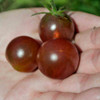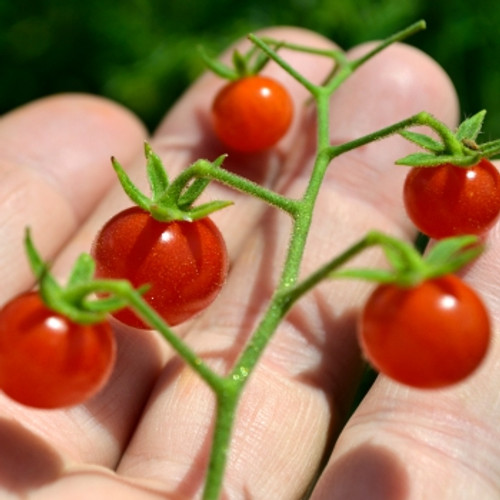Honkin' Big Black Cherry Tomato Seeds - (Lycopersicon lycopersicum)
- SKU:
- V1159
- Seed Count:
- Approx 25 seeds per pack
- Days to Maturity:
- 65-70 days
- Type:
- Indeterminate
- Size:
- Cherry
- Color:
- Black
- Organic:
- Yes
- Days to Germination:
- 5-7 days @ 75-95F
- Light Preference:
- Full sun
- Plant Spacing:
- 12"
- Status:
- Non-Hybrid, Non-GMO seeds
Description
Honkin' Big Black Cherry Tomato - Funny Name But Great Taste
Originally a “sport” or unknown tomato plant discovered growing outside Mayo Underwood’s garden around 1995. She let it grow and found the taste was outstanding – rich, complex and completely unexpected. Seeds were saved and it became a perennial hit with gardeners everywhere!
This sport produces strong plants with a ton of very large, “black” cherry tomatoes easily the size of a half dollar with a sweet/acidic/salty flavor. Early and delicious, production continues through light frosts.
History
Tomatoes were grown as a crop in Mexico and Peru in pre-Columbian times, but the early history of domestication is not well known (most likely in Mexico). In Europe, tomatoes were grown as ornamentals (thought to be poisonous) and became popular as a food only in the 18th century.
Uses
Raw or cooked the tomato is one of the most widely used and versatile foods from your garden. Use fresh in salads, sandwiches, and salsas. Cooked in sauces and stews. Can be stuffed, dried, puree, paste or powdered. The uses are endless!
Growing Tip
Tomatoes take about 3 - 4 months from direct seeding in the garden to start producing fruit; about 70 days from transplanting 6 - 8 week-old plants to start fruiting; and about 40-50 days from the flower opening to producing ripe fruit.
Tomatoes suffer more transplant shock than other vegetables, but you can minimize this by hardening them off for a week or two first. This means setting them outdoors in their pots in a protected place so that they get some warm sun, a little gentle wind, and even some cool (not freezing) nights. This will help them adjust to some of the stresses of real life before having their roots transplanted into the ground.
Tomatoes begin the ripening process by producing ethylene, a natural growth regulator, and releasing it. The fruit ripens from the inside out, meaning the center matures and turns red before the color reaches the outer skin. Faint white lines crossing each other at the bottom or blossom end of the fruit show that ripening has begun. Soon afterward, the blossom end starts turning pink – indicating ethylene is being produced. When the pink blush reaches the stem, the fruit is about 75% ripe. The pink color deepens to red, starting from the blossom end and working its way upward.
Harvest Tip
A tomato’s flavor increases as it ripens, due to the increased nutrients and sugars pumped into the fruit by the plant. For a home gardener, harvesting when there is just a touch of pink at the stem end or when the fruit is completely red gives the best flavor. The fruit will be fragile, won’t tolerate shipping and must be used or cooked within a few days to enjoy peak flavor.
Once the tomato is ripe, test by giving it a gentle pull or twist. If it slips easily from the vine – with little to no effort – it is ripe, juicy, and delicious!
Ripe tomatoes can be injured by cool temperatures and must be stored at room temperatures, never refrigerated to avoid chilling injury, which leaves pockmarks or pits on the skin leading to early rotting.
If you need to harvest early due to weather or the end of the season, those fruits with a pink blush at the blossom end will ripen with almost full flavor. Those with the faint white lines can still ripen but won’t have the full flavor.
Learn More
- Growing Tomatoes 101
- Determinate and Indeterminate Tomatoes - What's the Difference?
- Heirloom Tomato Growing Tips
- Heirloom Tomato Leaves - Potato Leaf vs Regular Leaf
- Blossom End Rot - What To Do
- Fermented Tomato Conserve
- Sicilian Eggplant and Tomato Sauce
From the soil to the seed to the food you eat - we'll help you grow your best garden!
2 Reviews
-
Funny Name Great Taste
When this variety was introduced I got such a kick out of what was written in the catalog about it I thought they deserved to sell some seed just for the sake of their sense of humor so I bought a packet. Then I gave a few plants to a friend to try. Not only did I decide I liked this one well enough to give it a permanent place in my garden, my friend told me she went out to her garden and turned around to catch her little dog carefully picking and eating only this variety. She said its her favorite also. Definitely a great find!
-
My Second Year Attempt
I may have mixed up my labeling last year but I was pleasantly surprised to grow out a beautiful plant that had half dollar size tomatoes that were the best tasting ever and yet did not appear black at all. I am wondering if the plant has not stabilized yet. This year I am starting new plants from the same seed package and also growing out six plants from seeds I saved from last years tomatoes. One of those six is potato leafed and the other five are regular. I will see what happens this year. I am very excited about this trial because these were really the best tasting tomatoes I have ever grown. I will make a follow up post at the end of the season and let you know what I learned.



















